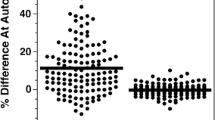Abstract
Postmortem computed tomography (pmCT) is increasingly applied in forensic medicine as a documentation and diagnostic tool. The present study investigated if pmCT data can be used to estimate the corpse weight. In 50 forensic cases, pmCT examinations were performed prior to autopsy and the pmCT data were used to determine the body volume using an automated segmentation tool. PmCT was performed within 48 h postmortem. The body weights assessed prior to autopsy and the body volumes assessed using the pmCT data were used to calculate individual multiplication factors. The mean postmortem multiplication factor for the study cases was 1.07 g/ml. Using this factor, the body weight may be estimated retrospectively when necessary. Severe artifact causing foreign bodies within the corpses limit the use of pmCT data for body weight estimations.



Similar content being viewed by others
References
Jackowski C (2013) Special issue on postmortem imaging. Forensic Sci Int 225:1–2
Persson A, Lindblom M, Jackowski C (2011) A state-of-the-art pipeline for postmortem CT and MRI visualization: from data acquisition to interactive image interpretation at autopsy. Acta Radiol 52:522–36
Rutty GN, Brogdon G, Dedouit F et al (2013) Terminology used in publications for post-mortem cross-sectional imaging. Int J Legal Med 127:465–6
Michaud K, Grabherr S, Jackowski C et al (2014) Postmortem imaging of sudden cardiac death. Int J Legal Med 128:127–37
Egger C, Vaucher P, Doenz F et al (2012) Development and validation of a postmortem radiological alteration index: the RA-Index. Int J Legal Med 126:559–66
Tomkins A (1981) Nutritional status and severity of diarrhoea among pre-school children in rural Nigeria. Lancet 1:860–2
Abe T, Kearns CF, Fukunaga T (2003) Sex differences in whole body skeletal muscle mass measured by magnetic resonance imaging and its distribution in young Japanese adults. Br J Sports Med 37:436–40
Jackowski C, Thali MJ, Buck U et al (2006) Noninvasive estimation of organ weights by postmortem magnetic resonance imaging and multislice computed tomography. Invest Radiol 41:572–8
Acknowledgments
The authors are grateful to Dr. Chunliang Wang (Center for Medical Image Science and Visualization, CMIV, University of Linköping, Linköping, Sweden) who programmed the Mia Lite plugin for Osirix, and Julia Brünig (Institute of Forensic Medicine, University of Bern) for helpful brainstorming.
Author information
Authors and Affiliations
Corresponding author
Rights and permissions
About this article
Cite this article
Jackowski, C., Schwendener, N., Zeyer-Brunner, J. et al. Body weight estimation based on postmortem CT data—validation of a multiplication factor. Int J Legal Med 129, 1121–1125 (2015). https://doi.org/10.1007/s00414-015-1199-x
Received:
Accepted:
Published:
Issue Date:
DOI: https://doi.org/10.1007/s00414-015-1199-x




